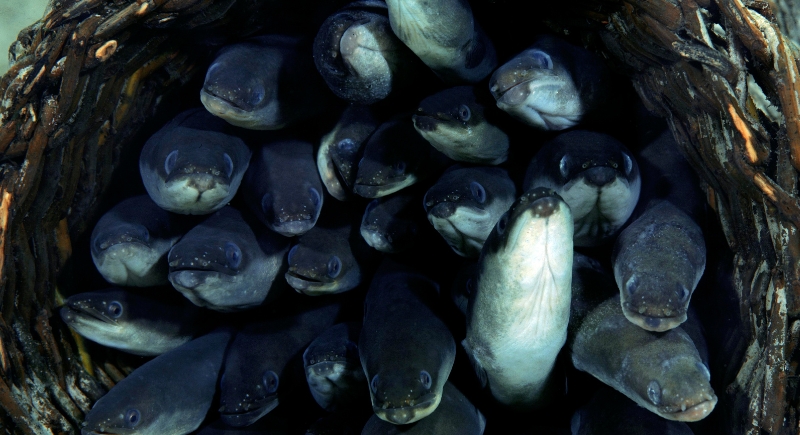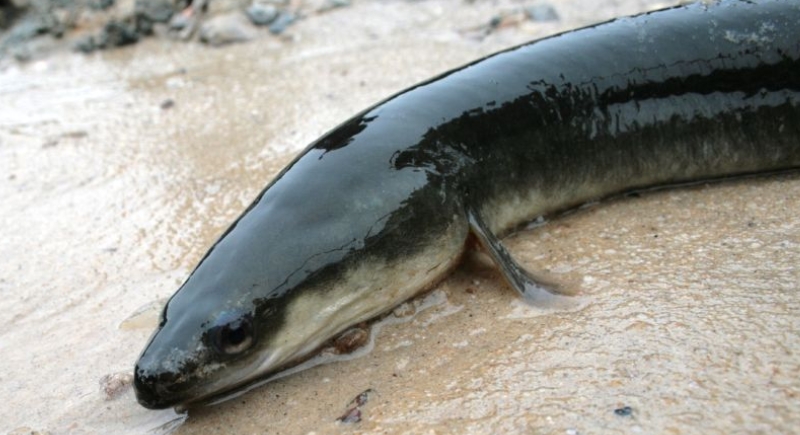Scientists Finally Figured Out the Bizarre Way Eels Reproduce
For centuries, eels have appeared in myths, on plates, and in human imagination while holding on to one enduring secret: how do they reproduce? Ancient Egyptians thought the sun shining on the Nile created them. Greeks and Romans believed they came from scraps of eel skin. Medieval Europeans even suspected they avoided reproduction altogether, which made them a common “safe” choice during religious fasts.
The mystery was fueled by one odd fact: eels didn’t seem to have reproductive organs until very late in life. Now, after years of chasing them across oceans and through their strange life stages, scientists have finally pieced together much of the truth. Although no one has yet observed actual spawning or eggs, recent studies have provided the clearest evidence so far of their breeding grounds. And it’s even stranger than anyone expected.
The Many Faces of an Eel

Image via Getty Images/slowmotiongli
The European eel (Anguilla anguilla) lives a complicated life. Born in the Sargasso Sea, it begins as a nearly transparent larva called a leptocephalus. These strange, leaf-shaped creatures float for thousands of miles on Atlantic currents before reaching the coasts of Europe. Once there, they transform into tiny glass eels, still see-through but starting to resemble their parents.
They often appear in huge numbers on Spain’s Atlantic coast, where they are considered a delicacy despite having little flavor. Their high value has also made them prime targets for smugglers, with suitcases full of glass eels being intercepted on the black market.
As they grow, glass eels turn into yellow eels, living in rivers, lakes, and estuaries for up to 25 years. Eventually, they morph again into silver eels, sleek and shiny, with only one mission left: a one-way trip back to the Sargasso Sea.
Long Swim Home
For decades, scientists could see eel larvae in the Sargasso Sea but had never found adults or their eggs, leaving a significant gap in the story. That changed in 2022 when researchers tagged 26 European eels near the Azores and followed their movements. Twenty-one of them transmitted valuable migration data, and five tags later surfaced within the Sargasso Sea, strongly confirming the theory that this is where spawning takes place.
Along the way, researchers learned why eels are so difficult to track. Their migration is slow, sometimes lasting up to 18 months. By day they remain between 500 and 1,000 meters deep, rising closer to the surface at night. They can dive farther on occasion, but depths of 4,500 feet are unusual. During this journey, their digestive systems shut down while their reproductive organs mature.
America Joins the Story

Image via Wikimedia Commons/Clinton & Charles Robertson
European eels aren’t the only ones with this bizarre life cycle.
American eels (Anguilla rostrata) follow the same strange path. For more than a century, scientists suspected they spawned in the Sargasso Sea, based on larvae found there since 1904.
In 2015, Canadian researchers tagged eels from Nova Scotia and the St. Lawrence Estuary, and one of them traveled nearly 2,400 kilometers (1,491 miles) to the northern boundary of the Sargasso Sea. This did not document spawning itself but provided direct evidence of their migration route.
The data showed they don’t cling to coastlines the whole way but head straight across the open ocean, likely using Earth’s magnetic field and environmental cues to guide them. These findings added critical support to the long-standing theory that the Sargasso Sea is indeed their mysterious breeding ground.
Trouble Ahead for These Mysterious Fish
As incredible as these discoveries are, the number of young glass eels reaching Europe’s coasts has dropped by more than 95% in recent decades. Dams block their inland migrations, and illegal trade adds even greater pressure. Both European and American eels are now considered highly endangered.
Recent tracking breakthroughs have given us the best evidence yet of where and how eels reproduce, but the full mystery isn’t entirely solved. Protecting their habitats and migration routes is now the real challenge. After centuries of myths and failed searches, we are closer than ever to knowing the truth about their bizarre reproductive journey. The question is whether these slippery survivors will keep making their way back to the Sargasso Sea for generations to come.